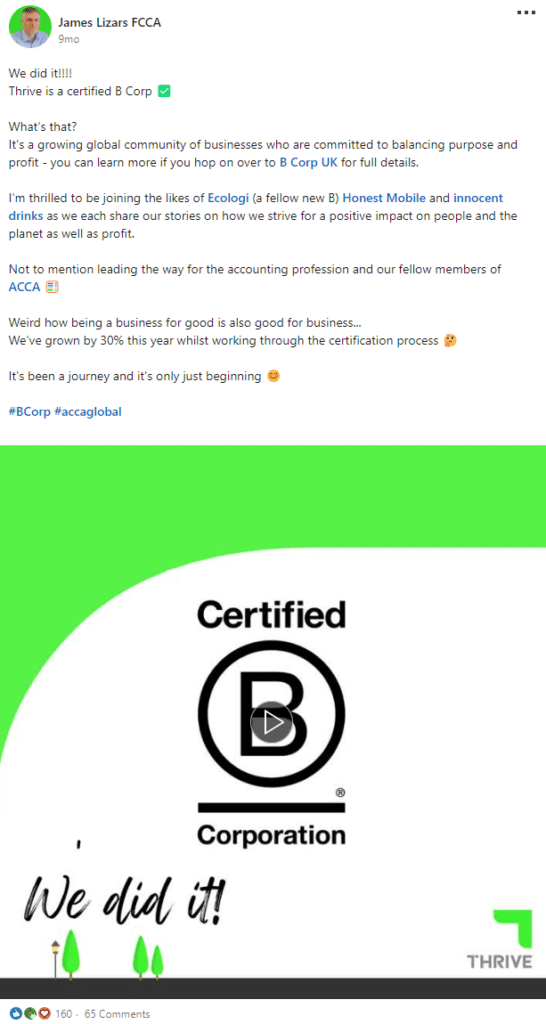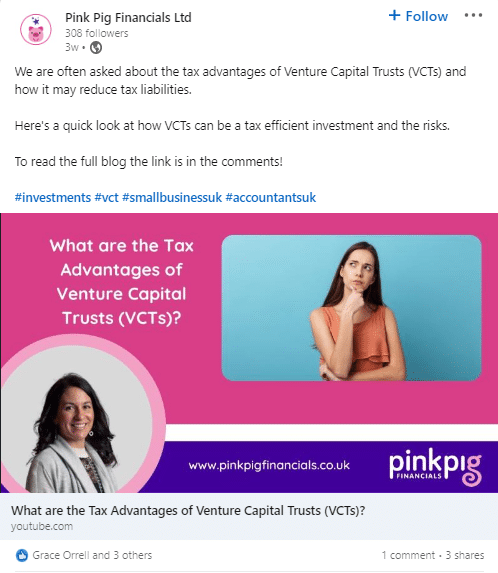Watch this 7min 32 secs tutorial video including examples from accountants who are posting content which truly reflects them and their firm:
Here’s how it goes a lot of the time when it comes to accountants posting on social media: You grab a spare 10 minutes while you’re waiting for your coffee to brew and open up one of your social media apps. And then your mind goes blank.
What do you write a post about? Your team? Your breakfast? The coffee that’s currently brewing? A client you had a great chat with last week? (Side notes, yes to all of these!).
Or, you have something important happen and you rush to post it – and in the process realise you haven’t posted anything for three weeks.
It can feel like there’s too many options and no options all at the same time. And you’re not sure if this is what you most want to say and how it fits with your brand and oh, look at what that other accountant posted. So you scroll for a few moments and coffee is ready. You return to what you were doing before and tell yourself you’ll post another day.
To help you with the mind blank part, you’ll find below a list of 38 ideas you can use to create social media content which truly reflects your accounting firm. You don’t need to do all of them at once, and some of them you’ll use time and time again. There’s a mixture to help you get the balance between sharing personal updates, things about your team, your services and your clients. (And if you’re wondering why it’s 38, that happens to be the number of ideas I came up with when writing this blog post!)
Use these ideas and categories and follow the 80:20 rule so your content is genuinely helpful and authentic rather than salesy and generic
The 80:20 rule means 80% of your posts on social media need to be “non-promotional”, and the other 20% “promotional”.
Non-promotional posts mean anything related to you, your team, your brand, your values, your knowledge… anything which isn’t directly selling the services you offer. This type of content helps you build relationships and specifically addresses the problems your ideal audience have, and the questions they want answered.
Promotional posts include anything related to the services your firm offers: resources you’ve created, an event you’re running, a role you’re hiring for or a new service you have launched. This is all content directly related to promoting your services and firm.
You’ll see below there are 32 non-promotional post ideas and 6 promotional post ideas. This is reflective of the 80:20 rule and how social media is best used to build relationships and connection with your audience so they can get to know you better and make their buying decision faster.
Non-promotional post ideas: anything related to you or your team
Content which helps your build relationships:
1. An in-person image from team get togethers/Zoom screenshots
View this post on Instagram
2. A picture from of your lunchtime walk view
3. Take a selfie with a client (and ask their permission to share it)
4. Tell a personal story i.e. talk about a hobby you have outside of work
5. Share your mission & purpose i.e. why your firm exists

6. Talk about your values i.e. share examples of how you/your team live them out
7. Recommend a book you’re reading/have read which would be helpful for your ideal audience
8. Share a victory or failure from your week
9. Post a picture of your pet or multiple pictures of team member’s pets
10. Talk about new team members
11. Share holiday related posts i.e. “we’ll be closed for the May bank holiday”
12. Ask your followers for help i.e. “does anyone have experience of Dext?”
13. Show the behind the scenes of a day in the life of an accountant i.e. tell a story or share a short video
14. Share a picture of your office space
15. Post a transformation post i.e. turning paper receipts into digital ones; a desk clear up; your firm’s rebrand
16. Share your top 3 learnings from being an accounting firm owner
View this post on Instagram
Content which specifically helps your ideal audience:
17. Answer a question your clients regularly ask you i.e. what is cash flow?

18. Share helpful tips i.e. how to claim tax-free childcare
19. Post new guidance/legislation updates which will affect your ideal audience
20. Regular reminders of upcoming deadlines i.e. self assessment payment deadline
21. Share a testimonial from a client who you love to work with (and want more of!)
View this post on Instagram
22. Share key points from a blog post you’ve written i.e. here are the top 3 takeaways and post a link to the full blog post
View this post on Instagram
23. A ‘how to’ tutorial video i.e. how to reconcile invoices on Xero
24. Repost an industry article which is relevant to your ideal audience
25. Share a podcast recommendation including what you love about it
26. Talk about your favourite software and how it helps your clients
27. Tell a story about a client you’ve helped i.e. what their problem was when they came to you, how you helped them fix it and how that changed their business/life
28. Post details of a webinar you’re speaking on i.e. as a guest or panel member
29. Share details of a webinar your firm is running
30. Talk about any awards your firm is nominated for
View this post on Instagram
31. Post pictures of swag from an industry attend you’re attending
32. Use images or short videos to show what happens first when a prospect signs their proposal i.e “here’s the first 3 things we’ll do first, here’s the first 2 you’ll do”
Promotional posts: anything related to the services your firm offers
33. Share details of a free download or resource you’ve created i.e. a PDF guide, a checklist, a tutorial video
Together with WiseSync we’ve created the monthly close checklist, specifically for the MSP Industry.
Download your copy now to make month end a breeze. Just click the link: https://t.co/QV3QzXSd7Y pic.twitter.com/9Nj1p5Xlb3
— Red Earth CPA (@redearthcpa) August 29, 2022
34. Post about roles you’re currently hiring for
Qualified (or very nearly) accountant?
Love working closely with creative businesses?
We’re looking for a Client Manager to join our lovely, award winning team, if anyone is looking for work or knows someone who is please send them our way 😁#team #accountant #hiring
— Raedan (@raedanCA) June 28, 2022
35. Share a link for people to register to get email updates and include 1. Who the emails are for 2. How it will help them 3. What they’ll get when they sign up
36. New service launch post i.e. “we’re now offering bookkeeping services and here’s how this will help you”
37. Talk about your small paid offering i.e. a series of training sessions or a masterclass, prospects can book and join
View this post on Instagram
38. Explain the best way for people to get in touch with you first i.e. fill out our discovery form
Steal like an artist from people and posts you like and admire
You’ll know from scrolling through your own social media platforms how often you see similar types of posts. As a content creator, there is a limit to how many different types of posts you can create and share. It’s more about what makes them yours. You can copy the style and type of posts from someone else, and recreate it so it fits with your brand and values. This is what makes posts personal to you.
The ideas you get from other social media accounts don’t have to be accountants. They could be any type of business, or individual, whose content you like and can make your own. For example, you might see a local cafe sharing pictures of what baked goods they have on offer that day. They’re selling themselves by showing people what they’ll get when they come to the cafe. You can “steal” this principle by sharing a post talking about what happens first when a new client signs your proposal. This helps your audience to understand what will be expected of both them and you when they start working with you. The purpose of the post is the same as the cafes (helping set people’s expectations) but the content will be quite different.
Katie, one our Senior Graphic Designers at PF, created this video to showcase our new PF t-shirts. She stole like an artist from TikTok and used the concept of changing her outfit to the beat of the song. The original video she saw wasn’t from a creative agency and they weren’t showcasing their swag, but Katie was able to borrow the idea and use it to record a video we wanted for PF.
Talk to them, not at them
Like with all your marketing, your social media posts are for your audience. Those clients who you love to work with most (because they’re a values fit to both you and your firm) and who are most profitable to you (because you do your best work for them).
When you think about “your audience” it can be tempting to think of a group of people who you’re trying to get your message to. That group of people is made of single humans. All different people who own different businesses and live different lives. There’ll be similarities and crossover between them (that’s why they’re all in your audience) and you need to think of them as individuals. Talk to them as individuals, not at them as one big audience. Creating content for social media becomes easier when you take the attention away from one massive group and focus on one individual person.
Choose one of your existing favourite clients and think about: What would that one client be interested in hearing from you? What would help them to start a conversation with you? Use these answers to help guide what posts you can share to build connections and help that one individual in your mind (who represents your whole audience) make their buying decision, faster.
Karen Kennedy does this brilliantly in the videos she regularly shares on her social media platforms. Karen works with small businesses in her local community and her connection to the people and involvement in the community means she knows how to communicate well with her audience. The words she uses, the banter she has and even the locations she records her videos (usually out on a walk in the local area) helps her audience to feel she is speaking to them as individuals.
Look at your calendar for post ideas
Around 80% of the effort with social media is in the planning. The actual setting up of the post and sharing doesn’t take much time or effort at all. The better you plan your social media calendar, the most consistent you’ll be with posting.
One way to get into the habit of planning is to look at your calendar for what you have coming up in the next months which you’ll want to tell people about. A webinar, a masterclass, an event, a tax deadline, a team fun day, a client meeting… loads of the ideas above will be planned out in your calendar already. Make it easier for yourself by using your calendar as a guide for what content you can prepare to share that month.
One of our clients, Caroline, uses the PF Lab action session time to plan out the next month of her social media posts. She looks at her calendar to see what she has coming up that month, any announcements she’ll want to share with her clients or any important deadlines she wants to highlight. Caroline then uses the 1 hour action session time to create a plan for the next month so she doesn’t have to spend time each day wondering what to post. She’s shared how much progress she makes each time she dedicates the time to it, and how helpful it is using her calendar as a guide for what content to create.
I’ll be honest, creating content for social media is one of the most time consuming tasks you’ll do in marketing. As a full time Marketing Manager, I’d estimate around 25% of my time each month is spent on social media. To encourage you, it becomes easier and quicker when you’re clear on who your audience is and what problems you can help them with. It shifts the focus from you to them and that relieves some pressure. I know as accountants you want to help people. Posting content on social media and sharing your knowledge and expertise is just another way of helping people.
You need to be somewhat involved in your social media so it truly reflects you and your accounting firm. We can work with you to create content and schedule your posts so if that’s something you need help with, go ahead and tell us about you, your firm and where you most need help with social media in our discovery diagnostic.

